
Marin Community Clinics wants to do more than identify and treat adverse childhood experiences (ACEs) among its patients — it wants to help families avoid them In the first place. And part of that means working on sustainable funding for prevention.
This is especially important because ACEs are linked to a higher risk of many chronic diseases across the lifespan as well as a higher risk of depression, suicide, and drug use. “Our hope is to change our system as a whole from a reactive system to a preventive system,” explains former clinic pediatrician Dana Jackson.
Although providers, for example, will continue to treat people with a substance use disorder who are living on the streets, Jackson says, they want to fix the problem that’s putting them there. “We are going to help the single mom who’s pregnant with her second kid and can’t find housing so that she and her family don’t end up on the street.”
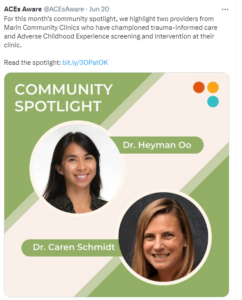
Dr. Heyman Oo and Caren Schmidt, PsyD, of Marin Community Clinics were featured in a case study by ACEs Aware.
Jackson, who graduated from medical school about seven years ago, notes that during her training there was no education around ACEs. “I think that’s changing now, but it wasn’t something then. I think there’s a lot of relevant information for medical clinicians that we didn’t get or think about.” She understands from first-hand experience the vital need to train all clinical care team staff in ACEs and trauma-informed care.
The California Surgeon General’s office has made screening adverse childhood experiences (ACEs) and subsequent toxic stress a core priority. Launched in 2019, the state’s ACEs Aware initiative was created to train primary care providers to routinely and consistently screen and treat pediatric patients for ACEs. Marin Community Clinics (MCC) was an early adopter of this practice, beginning with its own screen and then with the now widely used screening tool known as PEARLS (Pediatric ACEs and Related Life Events Screener). The California clinic is a leader in the federally qualified health center field for its work in this area. MCC—in collaboration with the ACEs Aware Initiative—helped create a model case study for implementing ACEs screening practices for healthcare sites across the state.
Now that ACEs screening and treatment is standard care at Marin Community Clinics, the organization is working on its goal of preventing these challenges in the first place by exploring other sustainable funding and reimbursement streams, including an initiative known as PRACTICE. In September 2022, the safety net health center was one of 25 California clinics funded through PRACTICE, with the mission of increasing the capacity of Medi-Cal primary care clinics, community-based organizations, and Medi-Cal managed care plans to address toxic stress in local communities.
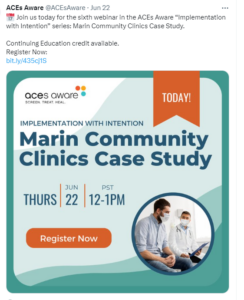
Marin Community Clinics is becoming a leader in the field of ACEs screening and treatment. Credit: Twitter
Marin Community Clinics, a member of CCI’s Resilient Beginnings Network (RBN), received a million dollar grant through PRACTICE, which is in turn funded by UCLA-UCSF ACEs Aware Family Resilience Network, in collaboration with the Office of the California Surgeon General, Department of Health Care Services, and the Public Health Initiative’s Population Health Innovation Lab. Three other Resilient Beginnings Network cohort members also received PRACTICE funding: Community Medical Centers, School Health Clinics of Santa Clara County, and UCSF Benioff Children’s Hospital in Oakland.
Besides the trauma prevention funding for Marin Community Clinics from PRACTICE and RBN — the latter a collaboration between the Center for Care Innovations and Genentech Charitable Giving — MCC receives additional support from CalAIM, short for California Advancing and Innovating Medi-Cal. CalAIM is a multiyear plan to transform and strengthen Medi-Cal, offering participants a more equitable, coordinated, and person-centered approach to health care while integrating programs to meet social needs such as food, housing, and employment. In an article for San Francisco Marin Medicine, MCC providers called CalAIM the “crown jewel” in the Department of Health Care Services’ ambitious plan to transform how Medi-Cal delivers care to the state’s most complex and vulnerable residents.
Implementing change in the face of challenges
The effort recognizes the interplay between trauma, social determinants of health, physical and mental health, and provides opportunities to integrate new support into healthcare practice. For example, the health center is integrating social workers and community health workers into primary care settings, so they can help individuals, families, and communities build on existing strengths while addressing barriers to care, including marginalization by healthcare systems, which can make some users feel invisible, with no consideration of their language, economic, cultural, or health access issues.
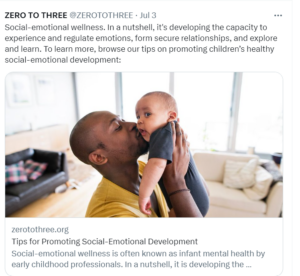
via Twitter
This approach allows clinics like MCC to add preventive pediatric initiatives, including Healthy Steps, which is designed to give caregivers of patients from birth through age five additional support to help their family thrive.
“Our goal is to be able to support children and their families as early in their life as possible so that our patients and their caregivers are set up for success,” says MCC pediatrician Leah Sitler. “Healthy Steps enables us to identify needs and areas where families could use some extra resources, support, and cheerleading, and to integrate these services into their already existing well visits.”
“Our hope is that in identifying areas of concern early in life we can take a preventative rather than reactionary approach for the inevitable difficulties that arise as children learn and grow in our world today,” Sitler continued. Healthy Steps, she said, “seeks to help address and support not only medical issues but also community resources and pediatric development, as well as behavioral and mental health needs.”
The health clinic also runs Triple P (Positive Parenting Program), which offers practical strategies to help parents build healthy relationships with their kids, manage their behavior, and prevent problems from developing. These efforts are designed to mitigate risk factors and provide skills and support to families before they are in crisis. MCC thinks of this as the care trifecta of primary care, behavioral health, and complex case management to address ACEs in a meaningful way. These kinds of program initiatives help clinics like MCC address the cycle of trauma and unmet psychosocial needs of patients and their families in a way that expands prevention and promotes resilience.
To take on that challenge, MCC has increased its response to positive screenings with a rich variety of evidence-based interventions and support for families. The health clinic focuses on treating the whole patient through its integrated behavioral health services, complex case management, nutrition counseling, alternative healing programs, and groups on parenting, teen mental health, and mindfulness. Many of these services are provided on-site.
Clinicians and staff report that ACEs screening enhances medical care, and that the act of ACEs screening has allowed providers to have conversations that they otherwise would not have had, notes MCC’s Caren Schmidt, a child psychologist and associate director of behavioral health at MCC. In addition, clinicians say they are able to discuss possible effects of ACEs and intervene with support for patients even before an issue has arisen, which further improves patient care.
Treating the whole patient before a crisis arises
Marin Community Clinics seeks to improve the health of its patients and community by providing high quality, cost-effective, culturally sensitive, patient-centered health care. It’s the largest provider of primary care, dental health, and behavioral health services to low-income residents in Marin County, which is also home to some of the wealthiest residents in the San Francisco Bay Area. The staff comes from the community MCC serves, and it serves a highly traumatized, largely immigrant population: Seventy percent of patients prefer to be served in a language other than English. MCC has also made training and capacity-building in staff a priority to become more trauma-informed as an organization.
The clinic has a long history of innovation around ACEs interventions. It began screening for
ACEs in 2017 as one of six pilot sites in the National Pediatric Practice Community on ACEs, a program of the San Francisco-based Center for Youth Wellness. The health center was also a participant in CCI’s Resilient Beginnings Collaborative (RBC), a precursor to RBN.
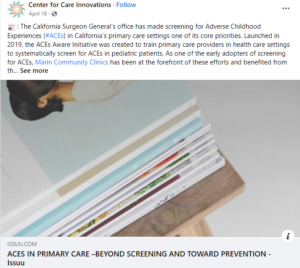
From Marin Community Clinics’ Twitter account
MCC has a robust screening program across all its primary care clinics. The health center now screens all pediatric, obstetrics, and adult patients for ACEs exposure. The clinics medical assistants and primary care providers are trained in how to introduce the ACEs screener and discuss the subject in a strengths-based, trauma-informed way. The organization has made a lot of progress to reduce the stigma associated with discussing traumatic experiences, which helps to build resilience amongst patients and staff alike.
“We try to normalize people’s experience and explain that a lot of people have benefitted from the resources we’re offering,” says Cayenne Bierman, a social worker and MCC’s director of complex care, which provides services to high utilization patients at the clinic who are struggling across multiple domains in their lives. Bierman is a project co-lead on the RBN program with Schmidt and pediatrician Tracey Hessel, the associate medical director for pediatrics at MCC.
But the reality is that the manifestations and treatment of trauma are often complicated and require support that goes well beyond the scope of the traditional primary care setting. And the need for such supports is high and continues to increase during challenging times, such as the recent pandemic, note MCC team members.
Building an algorithm of stressors
The health center has come up with an algorithm of stressors—including substance use, teen pregnancy, domestic and interpersonal violence, food scarcity, and housing insecurity—to help assess what a patient and family needs. The organization knowns from first-hand experience that people who have experienced trauma but get support can go on to be stable, safe, and grow. With Healthy Steps, for example, the team wants to identify issues early and offer on-going support through the program, specialists, behavioral health team, physicians, and community organizations to make sure patients have the resources they need to not just survive but thrive.
“We know that social determinants of health and ACEs exposure are mutually reinforcing and often one and the same thing,” says Bierman. “By addressing them both at the same time in a preventative way, we really have an opportunity to interrupt intergenerational cycle of trauma and ACEs — getting them when they’re kids, before the emergency and potentially preventing the next thing.”
The team has spent a lot of time, says Bierman, focusing discussions on how to take care of the whole person and the whole family and is working on a program initiative to center that concept, tentatively called the pediatric crisis response.
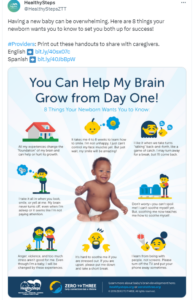
Healthy Steps l Zero to Three “provides tailored support for common and complex concerns that physicians often lack time to address, including behavior, sleep, feeding, attachment, parental depression, social determinants of health, and adapting to life with a baby or toddler.” (Source: Healthy Steps)
Implementing such changes can prove challenging. Bierman says: There was a year’s worth of upfront work to get to the point of actually implementing staff trainings for Healthy Steps. “There’s three units of trainings and one is for all staff, which was incredibly difficult to schedule, because that’s closing down our entire clinic for two hours,” she explains.
It’s not simply a matter of losing revenue, though; it’s that the clinic is already overburdened in terms of having the staff and time to see all the patients that need help. And beginning the program coincided with a shift in the organization’s electronic health records to OCHIN Epic—which only added to challenges in terms of creating new systems and workflows at a time when the center was also dealing with staff turnover, shortages, and burnout.
So rolling out these initiatives is by no means an easy lift, say MCC team members. To understand and implement new services and receive reimbursement involves significant administrative time. Safety net clinics are already operating beyond their bandwidth, so it can feel overwhelming to successfully add and integrate these services and to sustain buy-in momentum when roadblocks appear. During the peak of the pandemic, the behavioral health department in particular was consumed with putting out fires and dealing with crises, so it was tough to also focus on resilience during these unprecedented times.
That said, change is not insurmountable. And safety net clinics don’t have to go it alone. Networks such as Aliados Health (formerly Redwood Community Health Coalition) bring together peer groups of federally qualified health center providers implementing these services to recount their experiences with other organizations contemplating making these changes. “This is an excellent support that involves collaborations, brings clinic team members together, and shares best practices and ideas among peers,” says Bierman.
The greatest resource the MCC team shares is a commitment to serving the most vulnerable patients and supporting each other in these efforts. “We’re here to tell our peers you can do this, despite all the challenges and barriers,” says Bierman. “It can be difficult work with a lot of obstacles, but don’t give up. We remind ourselves what the goal is here: a system of care that meets the needs of all our children and their families. We’re in it for the long haul.”
Lessons Learned
Find creative ways to stretch funding for ACEs work. RBN and PRACTICE have helped MCC—through education, coaching, and training—to create a roadmap to access new reimbursement streams and services, say MCC team members. State compensation opportunities in the ACEs arena include the PEARLS tool, the dyadic services benefit, which covers behavioral health wellness visits for children, and payment for community health workers.
Implementing new screening tools takes practice. It’s good to have goals about how a clinic wants to integrate a new screening practice such as ACEs, even if those goals can seem unattainable in the reality of a clinic setting. Don’t let that challenge stop an organization from getting started. This is a team effort and adoption of new workflows depends on everyone’s participation. It’s important to involve the entire care team in every step of the process.
Solicit buy-in from the top. It’s important that leadership value trauma-informed work and offer the kind of support teams need—such as blocking out protected time to do training, education, and hold regular team meetings—to make such programs work. It sounds simple, but it is tough to do in clinics that are under-resourced and understaffed. MCC achieved buy-in from leadership for universal ACEs screening by demonstrating through data from the pilot program that screening enhanced medical care, and didn’t significantly disrupt the flow of care. The health center also showed that grant funding compensated for the time the champions spent working on the pilot, which was financially supported so that MCC could hire trainers to educate the entire staff on trauma-informed care.
Realize that buy-in is ongoing. The biggest takeaway for MCC on generating buy-in: It is not a single event. MCC had a green light from leadership to start ACEs screening but generating true buy-in means regularly revisiting workflows with stakeholders and taking the time to address concerns as a program evolves, adapts, and deals with challenges.
Recreating the wheel can strain limited resources. MCC contemplated designing its own Healthy Steps program, through its integrated behavioral health team. But the RBN team decided for now to stick with Healthy Steps, a successful program with evidence-based measures to back it up, despite some hurdles it has encountered along the way.
Schedule site visits. Seek out peers who are doing similar work and programming and build in time to see their efforts in real time, when possible, or virtually if not. There’s nothing like learning and connecting with other teams in the trenches. For instance, Children’s Health Center located at Zuckerberg San Francisco General Hospital and Trauma Center is a peer organization (and part of the RBN cohort) that already has a Healthy Steps program in play.
Marin Community Clinics is part of the Resilient Beginnings Network, a learning program that promotes trauma- and resilience-informed care so that 100,000 young children and their caregivers in the San Francisco Bay Area have the support they need to be well and thrive. The Resilient Beginnings Network is powered by the Center for Care Innovations, an Oakland-based nonprofit that fosters health equity and innovation in the health care safety net, and by Genentech Charitable Giving.
Marin Community Clinics was earlier part of RBC, which included seven safety net organizations in the San Francisco Bay Area, including three other teams now in RBN: Lifelong Medical Care, Petaluma Health Center ,and San Mateo Health Center. (The lessons learned from that earlier program are covered in this Center for Community Health and Evaluation report.)
Find this useful or interesting? We’re constantly sharing stuff like this. Sign up to receive our newsletter to stay in the loop.

